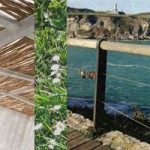Sustainable design is not necessary ecological. Instead, ecological design is environmentally sustainable.
Although it might be rather confusing, it is just about having clear what does each term refer to and knowing that everything looks the same but actually it is not.
It is has been a while since we started listening about these terms and, it seems like they define less and less as they multiply.
In addition to sustainable and ecological terms, we hear talking about energy efficiency, green building, organic products, carbon footprint, greencities… These terms are not synonymous although they are classified within the same trend, towards all the latest European Directives and consequently the national Directives are leading. Those terms are a representation of the increasing awareness developed lately about the impact of our actions in the future.
First of all we will compare: sustainability and ecodesign.
Sustainability is a much broader concept than ecodesign, or the use of ecological construction products. It covers fields such as environment, but also economy or social welfare. It is not enough for a building to be sustainable to have a high level of energy efficiency, and it must also be economically viable and do not alter location’s environment.
The goal is to create a balance between needs and resources used.
The tools to achieve this are several;
– Analysis of material consumption
– Reduction of waste generation
– Improvement in energy efficiency
– Guarantee of the system’s durability
– …
Covering the entire life cycle.
An energetically self-sufficient building, which does not require external components to meet its needs, would be a good example of the ideal energetic consumption situation. Anyway this would not be enough to guarantee the sustainability of the building, as only the energy field is covered and not other fields, such as water.
In addition the selection made for; the building’s construction, materials, impact on the surroundings, CO2 emissions, etc. should be taken into account.
As a consequence of the high complexity and development of the field, some other concepts have appeared to define specific areas that are easier to cover.
Ecodesign is the result of applying some of the sustainability aspects to the design process, being more focused on environment: it seeks to minimize the damage of the building on its surroundings. Thus, it defines protective and corrective measures. It is a term that has not been fully defined yet, so its use is still open to interpretation.
There are also ecological or environmentally friendly products, although its use will not define an entire building ecological.
Through ecodesign we achieve to define an overall strategy for the building, and propose its design according to specific requirements.
Sustainability and ecodesign are key aspects for the future of construction and must be addressed with all due seriousness. We must learn about these fields before we use them poorly and therefore they become empty of content too soon.
Buildings’ sustainability depends largely on the use made of it; there is hardly a point in designing and building a highly insulated building if the users do not use it properly, by fanning it the whole day. Precisely by making clients part of the project and explaining them the benefits of each detail, a better use of these qualities will be made.
The added value of sustainability and ecodesign will be recognized when society understands these terms. Among the partnership of all the specialists we will be able to share our knowledge with people around us, and extend its reach and value.
Pilar Saiz




